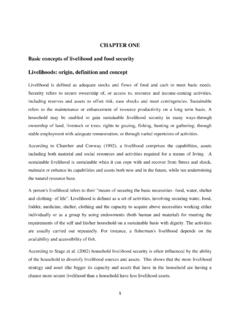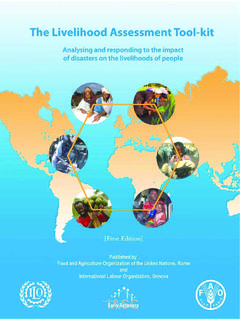Transcription of SUSTAINABLE LIVELIHOOD PROGRAM - World Bank
1 SUSTAINABLE LIVELIHOOD PROGRAM A PROGRAM that provides identified poor families the appropriate income-generating opportunities through microenterprise or employment, to help improve their level of economic sufficiency. Field Operations Manual SUSTAINABLE LIVELIHOOD PROGRAM Operations and Programs Group Promotive Programs Department of Social Welfare and Development March 18, 2015 CONTENTS Acronyms .. i Background .. ii Overview of the PROGRAM .. 1 Key Principles and Strategies .. 2 Key Implementers and Co-Implementers .. 2 Target Participants (Eligibility) .. 4 Operations Timeline .. 4 Stages of Implementation .. 5 1-3. Area, Participant, and Project Identification .. 5 Data Collection and Analysis: The Opportunity Identification Matrix .. 5 Initial Area, Participant, and Project Identification: C / MIAC Consultation and the Barangay Ranking Matrix .. 11 Community Validation and Consultation .. 13 Final Area, Participant, and Project Identification: Municipal Project Development and Assessment.
2 14 4. Project Review and Approval .. 17 Proposal Enhancement and Endorsement: Provincial Project Development and Assessment Workshop .. 17 Submission for Approval .. 18 Proposal Approval and Processing of Documents .. 18 Procurement Process .. 18 Community-level Project Review and Planning .. 19 5. Project Implementation .. 20 Skills Training (ST) .. 20 Pre-Employment Assistance Fund (PEAF) .. 20 Cash for Building LIVELIHOOD Assets (CBLA) .. 20 Seed Capital Fund (SCF) .. 20 Special Project Approaches .. 20 6. Monitoring and Evaluation .. 21 Data Gathering and Encoding .. 21 Data Validation .. 22 Data Processing and Analysis .. 22 Report Preparation and Submission .. 22 Recommendations for Follow through on Implementation .. 22 Community Consultation for Identification of Next Steps .. 23 Results-based Evaluation .. 23 Recommendations for PROGRAM Enhancement .. 23 LIST OF TABLES AND FIGURES Table 1. PROGRAM Operations Timeline.
3 4 Table 2. Summary of suggested data sets and sources for PROGRAM scoping .. 5 Table 3. Opportunity Identification Matrix (with recommended content) .. 7 Table 4. Sample Opportunity Identification Matrix for labor market opportunities .. 8 Table 5. Sample Opportunity Identification Matrix for product market 9 Table 6. Sample Opportunity Identification Matrix for service market opportunities .. 10 Table 7. Barangay Ranking Matrix .. 11 Table 8. Sample Barangay Ranking Matrix .. 13 Figure 1. PROGRAM Operations Flow .. 1 Figure 2. Interrelatedness of Area, Participant, and Project Identification .. 5 Figure 3. General Process for Area, Participant, and Project Identification .. 5 Figure 4. Intervention Identification Decision 16 Figure 5. General Process for Project Review and 17 Figure 6. Project Proposal Summary Sheet .. 18 Figure 7. Project Assessment Tool .. 18 Figure 8. General Process for Monitoring and 21i ACRONYMS AC Area Coordinator PDO Project Development Officer BA Barangay Assembly PEAF Pre-employment Assistance Fund BSPMC Barangay Sub-Project Management Committee PESO Public Employment Service Office BUB Bottom-up Budgeting PSA Participatory Situation Analysis C / MAO City / Municipal Agricultural Office PWD Person With Disability C / MAT City / Municipal Action Team RBME Results-based Monitoring and Evaluation C / MENRO City / Municipal Environment and Natural Resources Office RIS & PR Requisition and Issue Slip and Purchase Request C / MIAC City / Municipal Inter-agency Committee RPC Regional Project Coordinator C / ML City / Municipal Link RPMO Regional PROGRAM Management Office C / MSWDO City / Municipal Social Welfare Development Office SB Sangguniang Barangay CBEP Community-Based Employment PROGRAM SCF Seed Capital Fund CBLA Cash for Building LIVELIHOOD Assets SFP Supplementary Feeding PROGRAM CCG
4 Community Core Group SKA Self-Employment Assistance-Kaunlaran Association CCM Commodity Cluster Model SKP form SEA-K PROGRAM form CDED Community-driven Enterprise Development SLP SUSTAINABLE LIVELIHOOD PROGRAM CF Community Facilitator SLPA SUSTAINABLE LIVELIHOOD PROGRAM Association CSO Civil Society Organization SLPIS SLP Information System DA Department of Agriculture SSS Social Security System DCC Day Care Centers ST Skills Training DENR Department of Environment and Natural Resources SWAD Team Social Welfare and Development Team DepEd Department of Education SWDI Social Welfare and Development Indicators DOE Department of Energy TESDA Technical Education and Skills Development Authority DOLE Department of Labor and Employment TIN Tax Identification Number DOT Department of Tourism DPWH Department of Public Works and Highways DSWD Department of Social Welfare and Development DTI Department of Trade and Industry DTS Dual Training System FDA Food and Drug Administration FO Field Office GIP Government Internship PROGRAM GIS General Intake Sheet HAF Household Assessment Form JSDF Japan Social Development Fund KC-NCDDP KC - National Community-Driven Development PROGRAM LGU Local Government Unit M&E Monitoring and Evaluation MFI Microfinance Institution MFO Major Final Output MIBF Municipal Inter-Barangay Forum MOV Means of Verification NBI National Bureau of Investigation NPMO National PROGRAM Management Office NSCB National Statistical Coordination Board OJT On-the-Job Training OSY Out-of-School Youth PAMANA Payapa at Masaganang Pamayanan PC Provincial Coordinator ii BACKGROUND As a PROGRAM that aims for poverty alleviation, the SUSTAINABLE LIVELIHOOD PROGRAM , by nature, requires multiple strategies to be able to respond to a variety of poverty contexts and situations.
5 This need urges the PROGRAM management (National PROGRAM Management Office) and PROGRAM implementers (Regional PROGRAM Management Office) to continuously innovate and develop new methods and strategies to be able to provide the most appropriate and most effective set of interventions and achieve the intended results for the PROGRAM participants. This document was developed through the insights from the following sources: - Previous experiences from regular operations (Microenterprise Development and Employment Facilitation), and special projects ( PAMANA, Bottom-Up Budgeting, JSDF Community Enterprise Development as Pathway out of Poverty, post-disaster LIVELIHOOD rehabilitation and emergency employment projects) - Consultations and reports from field implementers, partners, and PROGRAM participants - Recommendations from expert consultancies, research, and studies conducted 1 OVERVIEW OF THE PROGRAM The SUSTAINABLE LIVELIHOOD PROGRAM (SLP) of the Department of Social Welfare and Development (DSWD) provides identified poor and vulnerable families and individuals the appropriate income-generating opportunities to help improve their level of economic sufficiency.
6 The PROGRAM s six main stages of implementation are 1) Area Identification, 2) Participant Identification, 3) Project Identification, 4) Project Review and Approval, 5) Project Implementation, and 6) Monitoring and Evaluation. There are two distinct features of the sequence of stages: - Stages 1 to 3 are very closely interrelated that during actual implementation, all three should be considered simultaneously (see section 1-3. Area, Participant, and Project Identification). - Stage 6, the last stage, directs the process back to stages 1 to 3, creating a cycle of planning, implementation, and monitoring and evaluation, to ensure that the necessary additional interventions are carried out, until the participants reach the targeted level of economic sufficiency (see section 6. Monitoring and Evaluation). The PROGRAM specifically targets the four economic sufficiency indicators of the Social Welfare and Development Indicators (SWDI)1 of the DSWD: a) employable skills, b) employment, c) income, and d) social security and access to financial institutions.
7 The PROGRAM facilitates interventions that expand the LIVELIHOOD asset base of the participants (human, social, physical, natural, and financial capital) to capacitate them in being able to either have gainful employment or successfully manage a microenterprise. MICROENTERPRISE DEVELOPMENT EMPLOYMENT FACILITATION Where limited employment opportunities exist or where PROGRAM participants exhibit exceptional potential for entrepreneurship and the market for products or services exist, the PROGRAM prepares its participants to manage their own enterprises. The PROGRAM facilitates different interventions to the participants for them to: - acquire / improve their entrepreneurial skills - gain knowledge and access to the different opportunities for supplier and client relationships - prepare for enterprise management ( group formation, business planning, asset acquisition) - establish a new microenterprise or enhance existing microenterprises Where various local job opportunities are available, the PROGRAM prepares its participants to be qualified and ready to enter employment.
8 The PROGRAM facilitates different interventions to the participants for them to: - acquire / improve their employable skills - gain knowledge and access to the available job opportunities - prepare for employment ( processing of documents, job application) - enter employment 1 The SWDI are used to determine the level of well-being of a family at the time of assessment. The results form basis for planning for interventions and for results monitoring. Figure 1. PROGRAM Operations Flow 2 KEY PRINCIPLES AND STRATEGIES Results-based Innovations Instead of having an activity-based and linear approach to implementation, the PROGRAM focuses more on a diverse range of options that the implementers must consider to more effectively and efficiently deliver the intended results. Although a standardized process, various activities, tasks, and tools are being developed and communicated to the field staff, the nature of the SLP still requires innovation and some ingenuity from the implementers for the strategies to fit the particular contexts of the project areas and / or the participants.
9 It should be understood that the implementers have the autonomy to move within the existing PROGRAM policies to be able to find the most appropriate approach to implementation to achieve PROGRAM goals. SUSTAINABLE Interventions PROGRAM implementers should focus on facilitating interventions that enable participants to experience long-term economic gains. The interventions themselves ( training, group formation, financial assistance, short-term employment) should not be seen as PROGRAM outcomes, but instead as outputs. These outputs take part of the LIVELIHOOD asset-building that contribute to the process of finding or developing a SUSTAINABLE income source. Guided Participation As a community-based PROGRAM , implementation should be based on participatory dialogue and consultation with the participants. This ensures the willingness and ownership of the participants throughout the interventions. However, it is equally important that field implementers properly guide the participants in identifying projects that will be SUSTAINABLE .
10 This can be achieved by extensive data-gathering and analysis through observation, research, consultation, and discourse with local key stakeholders. Field implementers should strive to achieve a certain balance between being participatory and being an effective facilitator. Multi-dimensional Approach Given the varying contexts of the areas and participants, the PROGRAM provides not a single intervention, but a set of options that can be taken individually or combined to be able to address the specific needs of the target participants. It is necessary for the field implementers to be able to identify the most appropriate intervention or set of interventions to ensure the sustainability of the resulting income-generating activity. Implementers should re-evaluate the participants needs even after conducting interventions and start planning for supplementary interventions to enhance or build on the results of the one preceding it.




